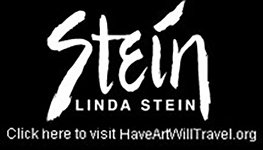NOTES ON MY OBSESSION. ESSAY FOR SMITH COLLEGE EXHIBITION CATALOG. 47 PAGES, 44 COLOR IMAGES – 2004
LINDA STEIN
Artist
It was as an artist in the 1970’s that I became obsessed with the face. It came on me rather suddenly, when my then current work involved the nude. I became completely focused on the face, and insatiable: as one seeking answers only to find more and more questions. I drew the face incessantly, creating drawings, paintings, prints, collages, sculptures, constructions–anything that could feed my frenzy.
Before long I became a face addict. On page after page in my diaries, as well as on any surface I could afford or obtain (restaurant napkins and place mats especially), the face became my motif of choice. The grid formation provided me with the opportunity to move quickly from one facial exploration to another and, with countless repetitions, my renderings of the face became unconscious and fluid.
Increasingly, as my brush or pencil strokes became more loose and free, the face became more abstract, sketchy, bold, funny, erotic. I had to try this facial motif in every manner and possibility that came to mind. One experiment, Esoterica 412, a series of faces in grid formation, was sketched while making love. I enjoyed the control I had to have over my body and hand. I reveled in encoding secret abbreviated initials under some of my sketched faces to indicate the various stages of lovemaking as I was experiencing it. I felt private pleasure when I eventually made the sketch into an etching which was exhibited and awarded in the International Print Biennial at the Yugoslavia Museum of Art. No one asked what the notations signified and I didn’t offer the information.
Over the years, my motif evolved into a facial profile, rather than full face, now with a significant caveat: no eyes. I was compelled to focus on the facial profile starting just below them. I found that I could not draw eyes in those days, however much I tried. There was an internal pull preventing me from drawing them. Why?
My guess now, thirty years later, is that it was because I was struggling with my sexual identity and wanted not to be seen. I was embarrassed, ashamed and in hiding. My life in those days was too confusing, too painful to have eyes on me, even from my own sketches. Without awareness, I started drawing the face just below the eyes. It wasn’t a conscious decision; it just happened.(You know, we artists think we are in control when we make art. We sometimes feel like gods or masters of the universe, but in reality, though we sit in the driver’s seat, we are merely acting as chauffeur. We take orders from some internal power and follow it feverishly.)
I saw profiles, sans eyes, in everything: stones, clouds, shadows, cracks in pavement, water. Hundreds of profile variations seeped out of me in every medium as I gravitated toward a personally generic and androgynous (or non-gendered) profile. If a viewer saw the face that I created as male or female, I would be taken aback, for gender had not occurred to me. What did consume me, albeit without congnizance, was that my invented profile have a prominent Greek-like nose, soft voluptuous lips and smooth curvilinear chin. Sometimes a neck and sweeping shoulder were included, as in the series called the Profile Landscape.
I would work continuously on one series until another beckoned and moved me along. I was charmed and seduced.The faces were all irresistible to me: the Profile Palette series, utilizing the paper on which I mixed paints; the Profile Fringe series blurring the contours of the face with short thread-like brush strokes; the Profile Marbled series; the Profile Hanging series; the Profile as if Wire Sculpture series; and many others. I had to have these faces, over and over again, in every possible mode. I had to possess them with pencil and brush, in collage and print. My appetite and passion were limitless.
It has been said that the artist Ingres “painted with his tongue.” For me, the pencil line of the nose slowly making the turn from its vertical descent to horizontal arc, has been grippingly sensual. The “u” under the nose for the indentation, the delicate lips, the powerful shoulder created a visceral response in me. Importantly, during the creative process, the angles, curves, darks and lights of these profile lines had to be done very carefully, according to my own set of rules; otherwise this charged fascination would not take hold. Eventually, as I followed these rules, my response grew autonomic and my hand became calligraphic and free. The profile motif took on many associations for the viewer: a page filled with lip notations looked like flying birds; profiles that were drawn in all directions on canvas combined with musical notes.
The work continued until a profile writing emerged. As this automatic fluency developed in my notational script, the teacher in me revived (I had taught high school art for seven years and been artist-in-residence for another seven), and I felt an urge to instruct anyone so inclined to write this way. I created A Guide to Profile Writing with a step-by-step set of instructions for the beginning Profile Writer. It included the necessary angles, the proper curves, the correct pressure of the pencil line.
I began writing missives made up of nose, lips, chin calligraphy, complete with what appeared to be salutation and return address, offset with commas, colons and other punctuation marks; and musical compositions with profiles neatly lined up as if they represented the chords of a composer’s score; and paintings reminiscent of long lost historical documents written in Hieroglyphics, Sanskrit or Egyptian.
Never have I known how it is that I enter or leave each series. It is not in the wanting that it happens. (I have learned to accept my chauffeur status.) I always keep working as if the current obsession will go on forever. Trying to stop it is futile. And so, continuing the current missive series with no end in sight, I picked up some bent nails one day. Instead of profiles, they looked like letters of the alphabet, this time to be glued onto wood instead of drawn on paper. Gradually, and once again without cognizance, the three-dimensionality of the material began to consume me and I was swept away in a new series of non-facial abstract assemblages using found objects in a calligraphic format. This was followed by a major sculpture series with a feminist/anti-war theme (see Stein, HLF Quarterly, Winter 2000, Vol. 1, No. 4, “The Machete Blade: An Artist’s Search for Security and Strength,” and www.lindastein.com). Eventually I thought that my face days were over (though residual remnants kept cropping up). During the next two decades I defined myself as sculptor, creating installations with video, panel discussions on violence and interactive spaces.
Then, one day in 2002, shortly after 9/11 and after some non-related surgery, both preventing me from doing sculpture, I came upon a set of separate facial profiles of Virginia Woolf that I had done in 1976. I found myself, once again, entranced by the facial arcs and areas I had created so long ago. It was like falling in love again, and I was being led by a mysterious magnetism. I decided to combine this set of Woolf’s profiles into a limited edition print with a grid formation highlighting the curves and lines so compelling to me over the years
In addition to Woolf, other people’s faces started to attract me, and before I could gauge what was happening, I was hooked. I started to do commissions of well-known faces and other less-known ones. Some were in grid formation and others had paper three-dimensionality; some became multiples and others remained as paintings. Unexpectantly, I soon was including eyes! Wanting the face to be recognizable, I must have felt that eyes were essential. Now, perhaps, as a more secure and confident adult, I could allow myself to be seen.
It is here where you find me: attached again to the face and absorbed with myriad ways to depict it. I call my current series Mood Portraits because it has an ambient element of abstraction which relates to my earlier work. As with my sculpture, I favor the tactile and include an intricate weaving of textured pattern created with the brush as if it were sewn with a variety of stitches. At certain creative moments, the feeling that my brush has been transformed into needle and thread has a soothing effect on me, mesmerizing. If I paint this pattern in bed late at night, it relaxes me to the point of putting me to sleep. These “sewn” areas move my portraits away from realism and add another layer of meaning. As I work, I become focused on areas of color, lines and textures that increase my excitement and pleasure.
An active feminist, I enjoy making portraits of internationally beloved women, especially when the finished pieces, as singles or multiples, are commissioned by a favorite non profit organizations as part of their fundraising activities. Then my political and social cravings as well as artistic ones are satisfied. Though I now do the full face, my preference is still doing portraits with a profile or three-quarter view. Transversing that “roadway” of nose/lips/chin lines is like a homecoming. It grabs me and makes me feel safe. Here I can rest and feel the security that comes with familiarity and repetition. I can thrive in my obsession with the face.

